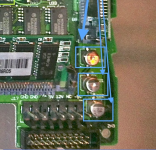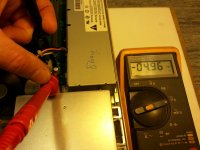paul.gaastra
Member
Hi,
Am I the first person to discover this? C22 (the 47uF capacitor in the corner beside the power supply connector) on our LCIII has the + sign on the PCB on the negative capacitor terminal. This capacitor is between -5V and ground.
The original C22 electrolytic on this board, and on another LCIII we have here, are installed the wrong way round electronically but the right way round according to the PCB silk screen. In other words I think all the LCIIIs ever made on those two board versions went out the door with C22 polarised the wrong way!
I only discovered this because I recapped this LCIII with tantalums and after a few hour's use the -5V supply was dropping to -2.1V. Putting an ammeter in series I found the current went to about 1.3A (far more than the 75mA rating). I replaced the cap with the -ve terminal soldered where the + sign is on the board and I have no problems :b&w:
As far as I can tell the -5V supply is only for the RS422 driver chips for the Appletalk and Modem ports. Would that be correct?
Am I the first person to discover this? C22 (the 47uF capacitor in the corner beside the power supply connector) on our LCIII has the + sign on the PCB on the negative capacitor terminal. This capacitor is between -5V and ground.
The original C22 electrolytic on this board, and on another LCIII we have here, are installed the wrong way round electronically but the right way round according to the PCB silk screen. In other words I think all the LCIIIs ever made on those two board versions went out the door with C22 polarised the wrong way!
I only discovered this because I recapped this LCIII with tantalums and after a few hour's use the -5V supply was dropping to -2.1V. Putting an ammeter in series I found the current went to about 1.3A (far more than the 75mA rating). I replaced the cap with the -ve terminal soldered where the + sign is on the board and I have no problems :b&w:
As far as I can tell the -5V supply is only for the RS422 driver chips for the Appletalk and Modem ports. Would that be correct?




